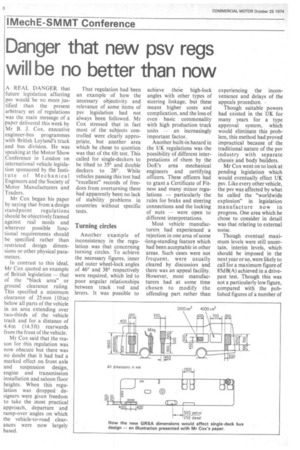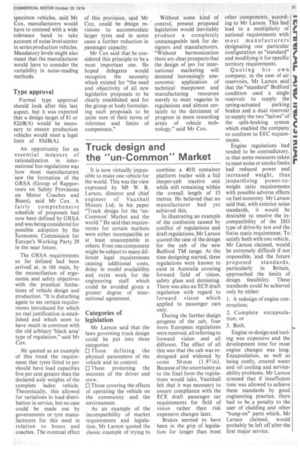Danger that new psv regs will be no better than now
Page 32

Page 33

If you've noticed an error in this article please click here to report it so we can fix it.
A REAL DANGER that future legislation affecting psv would be no more justified than the present arbitrary set of regulations was the main message of a paper delivered this week by Mr B. J. Cox. executive engineer-bus programmes with British Leyland's truck and bus division. He was speaking at the Motor Show Conference in London on international vehicle legislation sponsored by the Institute of Mechanical Engineers and the Society of Motor Manufacturers and Traders.
Mr Cox began his paper by saying that from a design standpoint regulations should be objectively framed against real needs and wherever possible functional requirements should be specified rather than restricted design dimensions or other physical parameters.
In contrast to this ideal, Mr Cox quoted an example of British legislation — that of the "black area" or ground clearance ruling. This specified a minimum clearance of 25 mm (10 in) below all parts of the vehicle in an area extending over two-thirds of the vehicle track and for a distance of 4.4m (14.5 ft) rearwards from the front of the vehicle.
Mr Cox said that the reason for this regulation was now obscure hut there was no doubt that it had had a marked effect on front axle and suspension design, engine and transmission installation and saloon floor heights. When this regulation was dropped designers were given freedom to take the most practical approach, departure and ramp-over angles on which the vehicle-to-road clearances were now largely based. That regulation had been an example of how the necessary objectivity and relevance of some items of psv legislation had not always been followed. Mr Cox stressed that in fact most of the subjects controlled were clearly appropriate, but another area which he chose to question was that of the tilt test. This called for single-deckers to be tilted to 35° and double deckers to 28°. While vehicles passing this test had "excellent" records of freedom from overturning there had apparently been no lack of stability problems in countries without specific tests.
Turning circles
Another example of inconsistency in the regulation was that concerning turning circles. To achieve the necessary figures, inner and outer wheel-lock angles of 46° and 38° respectively were required, which led to poor angular relationships between track rod and levers. It was possible to achieve these high-lock angles with other types of steering linkage, but these meant higher costs and complication, and the loss of even basic commonality with high production truck units — an increasingly important factor.
Another built-in hazard in the UK regulations was the possibility of different interpretations of 'them by the DoE's area mechanical engineers and certifying officers. These officers had to grant a Certificate of Fitness and many minor regulations — particularly the rules for brake and steering connections and the locking of nuts — were open to different interpretations.
Most vehicle manufacturers had experienced a rejection in one area of some .long-standing feature which had been acceptable in other areas. Such cases were not frequent, were usually cleared by discussion and there was an appeal facility. However, most manufacturers had at some time chosen to modify the offending part rather than experiencing the inconvenience and delays of the appeals procedure.
Though suitable powers had existed in the UK for many years for a type approval system, which would eliminate this problem, this method had proved impractical because of the traditional nature of the psv industry with separate chassis and body builders.
Mr Cox went on to look at pending legislation which would eventually effect UK psv. Like every other vehicle, the psv was affected by what he called the "worldwide explosion" in legislation manufacture now in progress. One area which he chose to consider in detail was that relating to external noise.
Though eventual maximum levels were still uncertain, interim levels, which should be imposed in the next year or so, were likely to call for a maximum figure of 85dB(A) achieved in a drivepast test. Though this was not a particularly low figure, compared with the published figures of a number of specimen vehicles, said Mr Cox, manufacturers would have to contend with a wide tolerance band to take account of noise level scatter in series production vehicles. Mandatory levels might also mean that the manufacturer would have to consider the variability in noise-reading methods.
Type approval
Formal type approval should look after this last aspect. but it was expected that a design target of 81 or 82dB(A) would be necessary to ensure production vehicles would meet a legal limit of 85dB(A).
An opportunity for an essential measure of rationalization in international bus regulations was _how most manufacturers saw the formation of the GRSA (Group of Rapporteurs on Safety Provisions on Motor Coaches and Buses), said Mr Cox. A fairly comprehensive schedule of proposals had now been defined by GRSA and was being considered for possible adoption by the Economic Commission for Europe's Working Party 29 in the near future.
The GRSA requirements so far defined had been arrived at, in the main, by the reconciliation of ergonomic and safety objectives with the practical limitations of vehicle design and production. "It is disturbing again to see certain requirements introduced for which no real justification is established and which seem to have much in common with the old arbitary 'black area' type of regulation," said Mr Cox.
He quoted as an example of this trend the requirement that tyres fitted to psv should have load capacities five per cent greater than the declared axle weights of the complete laden vehicle. Theoretically, this allowed for variations in load distribution in service, but no case could be made out by governments or tyre manufacturers for this need in relation to buses and coaches. The eventual effect of this provision, said Mr Cox, could be design revisions to accommodate larger tyres and in some cases a further reduction in passenger capacity.
Mr Cox said that he considered this principle to be a most important one. He hoped delegates would recognize the necessity which existed for "the need and objectivity of all new legislative proposals to be clearly established and for the group or body formulating such proposals to be quite sure of their terms of reference and limits of competence." Without some kind of control, present proposed legislation would inevitably produce a completely unmanageable task for designers and manufacturers.
"Without harmonization there are clear prospects that the design of psv for international marketing will demand increasingly uneconomic application of technical manpower and manufacturing resources merely to meet vagaries in regulations and almost certainly to the detriment of progress in more rewarding areas of vehicle technology," said Mr Cox.












































































































































